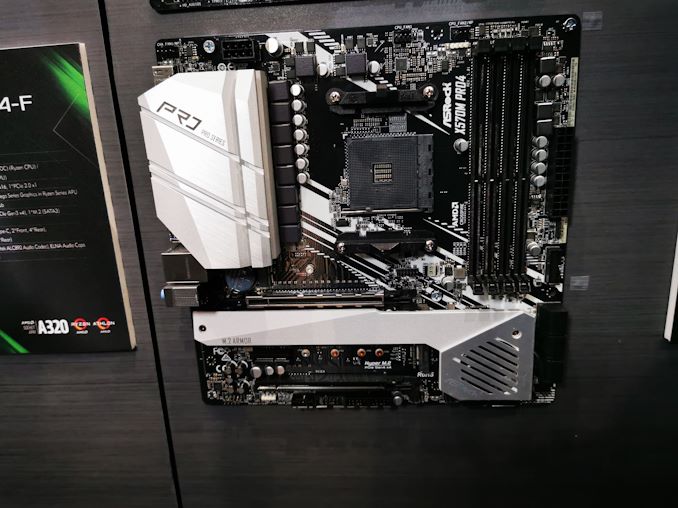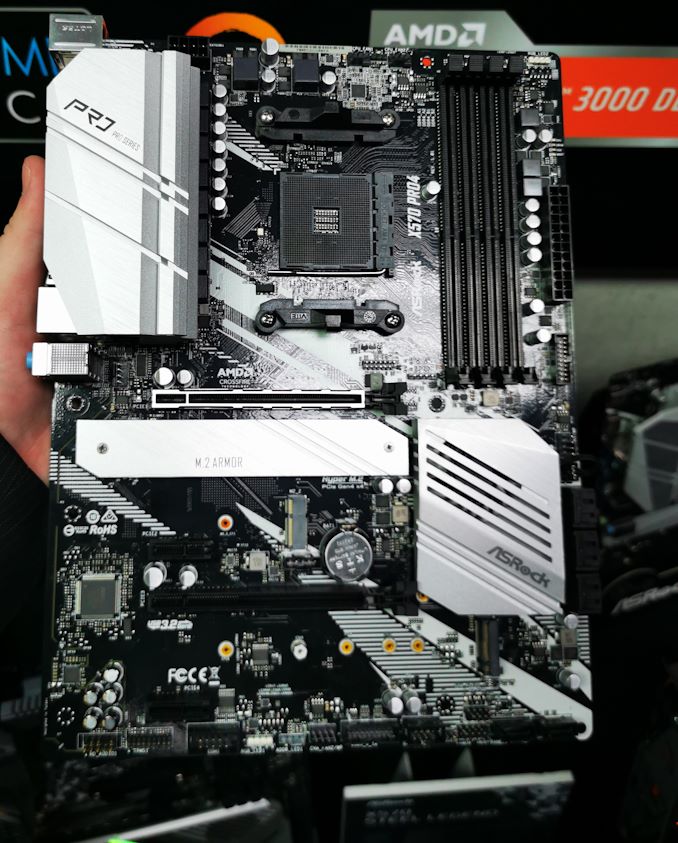The AMD X570 Motherboard Overview: Over 35+ Motherboards Analyzed
by Gavin Bonshor on July 9, 2019 8:00 AM ESTASRock X570 Pro4 & X570M Pro4
ASRock unveiled a number of its X570 models during Computex 2019: a lot of gaming-focused models, and some extremely high-end offerings, but the ATX sized ASRock X570 Pro4 and microATX X570M Pro4 looks set to offer users less bling and more functionality at a lower price point.
Starting with the design of the ASRock X570 Pro4 and X570M Pro4 models, both models use the same silver and black theme throughout, with shining silver heatsinks, and a solid looking aluminium rear panel cover which doubles up as the power delivery heatsink. Both the ATX and microATX models use the same 10-phase power delivery, with both opting to use a single 8-pin 12 V EPS CPU power input. Both have dual PCIe 4.0 M.2 slots with one M.2 heatsink, with eight SATA ports, and both also use an Intel Gigabit LAN port, and a Realtek ALC1220 HD audio codec.
The primary difference aside from the form factor is the ASRock X570 Pro4 naturally has more PCB space for extra PCIe connectivity. This includes two PCIe 4.0 x1 slots on the X570 Pro4 compared to the single PCIe 4.0 x1 on the X570M Pro4, but surprisingly, both feature two full-length PCIe 4.0 x4 slots and an M.2 Key E for users to add their own Wi-Fi/BT module. Both include a DisplayPort and HDMI video output on the rear panel, and four memory slots capable of supporting up to DDR4-4066 with a maximum capacity of up to 64 GB.

ASRock X570M Pro4 microATX motherboard at Computex 2019
The rear panel on both the ASRock X570 Pro4 and X570M Pro4 are identical in terms of connections and includes a single USB 3.1 G2 Type-A, a single USB 3.1 G2 Type-C, six USB 3.1 G1 Type-A ports, and a single Ethernet port powered by an Intel I211AT Gigabit controller. For audio, there are three color coded 3.5 mm audio jacks which is controlled by a Realtek ALC1200 HD audio codec.
It's clear that the X570 Pro4 and X570M Pro4 models are aimed at users with more a more professional focus; this is prevalent in the feature set and the aesthetic. There is nothing flashy about the Pro4, but it does represent a more modest offering in its X570 product stack with the X570 Pro4 priced at $170, with the X570M Pro4 coming in at a slightly higher MSRP of $186












225 Comments
View All Comments
PeachNCream - Tuesday, July 9, 2019 - link
Pretty much this. Modern games on DX12 won't see any benefit unless the game developer bakes in support (which they appear uninterested in doing for cost reasons) and older games run very well on a single modern GPU. AMD and NV are hardly acknowledging SLI these days either and nowhere but at the top end so there is even less compulsion for developers to bother with supporting it. All in all, you're better off not worrying about SLI unless the industry changes direction significantly in the next few years.ajlueke - Tuesday, July 9, 2019 - link
The real question however, is does all this power delivery actually have any practical benefits? If I drop a 3000 series CPU in an X570 board vs X470, can I achieve any additional performance? And what is the power consumption differences in the respective chipsets? That is the type of info I would like to see.PeachNCream - Tuesday, July 9, 2019 - link
It's a marketng differentiator only as motherboard manufacturers all use the same core components and are quick to emulate one another with similar features. Through branding and obscure features that do not significantly impact computer operation, they search for something they can offer that may encourage you to make a purchase in a very, very crowded field of offerings.lopri - Tuesday, July 9, 2019 - link
Solid power delivery for high-performance CPUs is perhaps the farthest thing from obscure marketing features. OEMs do play with marketing BS for differentiation, but the underlying power delivery system is extremely important and can impact everyday operation for these multi-core CPUs.PeachNCream - Wednesday, July 10, 2019 - link
At long as it meets AMD specifications, no it won't. If it doesn't meet specifications, then it's a bad design. There's no reason to tout being mediocre or a hair or two above mediocre unless you're running out of unique bullet points for the backside of the box that nobody bothers to read anyway.Death666Angel - Tuesday, July 9, 2019 - link
Stock performance will be the same across the board unless the manufacturer royally screwed up and the power delivery has to throttle due to temperatures (which there are some cases of with super cheap motherboards and 8 cores). Doing OC (and PBO is already OC) is where things start to change. More / better phases means less heat output and better voltages (ripple). This can potentially give you better clocks. But most of this is only useful when you start OCing on water or sub zero systems. Air cooled overclocking will hardly benefit at all. And regarding power consumption you can go into a lot of detail. Sometimes more power phases simply destroys efficiency, when they are all fired up all the time. Sometimes more power phases are smartly managed and load balanced to be kept at their optimal efficiency. It really depends on the implementation.Peter2k - Wednesday, July 10, 2019 - link
If you leave everything at stock, then there is no real reason to upgradeMost people would think keeping the socket backwards compatible as an upside
In a desktop the only real reason why we think about power draw going up from 5w to 11w is because manufactures like to keep the cooling block small, and those need a fan
Chipset fans bring back memories out of terrible noisy days
Also I remember chipset coolers to be a bit bigger in the past, I'm sure if you're just trying to provide food cooling, without trying to hit that gamer look, then you can cool that chipset without active fan
If you want to try your hand at OC'ing you should probably want the better power delivery
And there is no telling if the older boards will also run fine with higher memory speeds
Guessing they would, at least until the magical 3600, that's not that outlandish high
And how much that affects performance this time around still has to be tested
Short story
You have a Ryzen already, just make it a drop in replacement
No need to throw out the board
Peter2k - Wednesday, July 10, 2019 - link
Any one that would argue about the electricity costs going up (I've encountered those) should also not that all that shiny bling probably draws more watts then the 6w or so difference between last gen and this genpavag - Tuesday, July 9, 2019 - link
I expected benchmarks.sorten - Tuesday, July 9, 2019 - link
You expected benchmarks on 35+ boards that were released two days ago, and many of which aren't even available at retail?